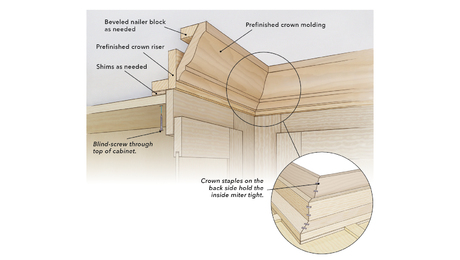Anybody still know how? Tried it a couple of times 50 years ago, made a mess but didnt burn myself too badly.
Discussion Forum
Discussion Forum
Up Next
Video Shorts
Featured Story

Use these assembly techniques when installing crown risers and molding to minimize visible gaps and nail holes.
Featured Video
How to Install Exterior Window TrimHighlights
"I have learned so much thanks to the searchable articles on the FHB website. I can confidently say that I expect to be a life-long subscriber." - M.K.
Fine Homebuilding Magazine
- Home Group
- Antique Trader
- Arts & Crafts Homes
- Bank Note Reporter
- Cabin Life
- Cuisine at Home
- Fine Gardening
- Fine Woodworking
- Green Building Advisor
- Garden Gate
- Horticulture
- Keep Craft Alive
- Log Home Living
- Military Trader/Vehicles
- Numismatic News
- Numismaster
- Old Cars Weekly
- Old House Journal
- Period Homes
- Popular Woodworking
- Script
- ShopNotes
- Sports Collectors Digest
- Threads
- Timber Home Living
- Traditional Building
- Woodsmith
- World Coin News
- Writer's Digest


















Replies
Sounds like one for the Old Plumbers' Home. I know a plumber in his 70's who worked in Michigan for many years and I am sure he learned to wipe lead as an apprentice. I'll have to ask him next time we talk.
Geez, I still have my ladle and half a box of oakum that I have'nt used in 25 years. ya never know...
How would you rate a poured lead oakum joint vs a no-hub connection? Longevity, etc
No, but I have a good supply of plumber's candles if you really want to go backwards.
I also have the bending springs that were inserted inside a length of lead pipe so you could bend your own 90's (or 89's, or 92's--whatever you needed.)
My old, old plumber's how-to book has a page of 13 rules for safe handling of lead. My favorites:
#3--"After having been in the dust or the fumes, spit a few moments thereafter."
#12--"Do not keep your mouth open when breathng; breathe through your nose."
#9--"Do not allow yourself to become constipated."
To wipe lead was basically a separate skill, you
would be pressed to find someone that can pour a
lead joint nowdays; most people don't know what you
are talking about.
Yep, most folks probably have never even seen a wiped joint. Still have a few pieces of asbestos cloth for wiping, but no 1-1/2 lead pipe left in the 'inventory' even.
As to the other post about longevitiy of oakum joints - I have seen CI pipe fail due to rust through from the inside out prior to the lead oakum seal failing.
Have personnaly seen wiped lead joints in Pompey that still appear functional after 2000 years.
Lead is great for longevity, and so are its alloys that go into solder--tin, antimony.
But now, instead of being afflicted with lead poisoning, everybody has come down with lead-phobia.
When I remodeled by house in Long Beach in 1977, I needed to connect my new ABS drain from the new bath/laundry to the old existing cast iron drain. At the time I was getting help from the old timer at the local plumbing supply store counter. He sold me oakum and "lead wool" to use to make the connection and explained how to do it. Worked like a charm. I tamped the oakum into the cast iron bell and followed with lots of lead wool carefully tamped in place with an offset lead caulking tool which for some strange reason I already owned. I think the idea is that lead is soft enough that the wool could be hammer compressed enough to be solid and leakproof.
I was glad to not fool with hot lead in the crawl space under the house. As I understand it, to make a good lead joint, the lead has to be just hot enough to flow and just cold enough to set up in the joint almost immediately on contact. I can see that level of expertise needing lots of experience to develop. I think lead joints were usually "finished" with the above mentioned caulking tool. My guess is that cooling lead could contract and get a little loose in the joint.
I took my Journeyman test 2 years ago, and they had switched from pouring lead joints as part of the test, to figuring your cast iron pipe lengths, and hooking them up with mission bands. Your work must fit into a 'Jig', perfectly and they check for proper torque.
Actually, I haven't even heard of anyone pouring a joint, they just cut out the area, and replaced it, using no-hub couplers, and PVC.
We still install cast iron sometimes, mostly 4", and underground, but we use a rubber hub and some kinda grease. I don't know how it holds up in the long run, but it looks good, and does seem to seal well.
plumber_bob: A lot of times it is more economical and
faster to pour a lead joint if you are set up to do
so.
The lube you are talking about is slip-seal lube; you
also use a adhesive-lube in certain situations. That
type of hook-up has been around since at least the
early 60s, I've never heard anything negative about
it.